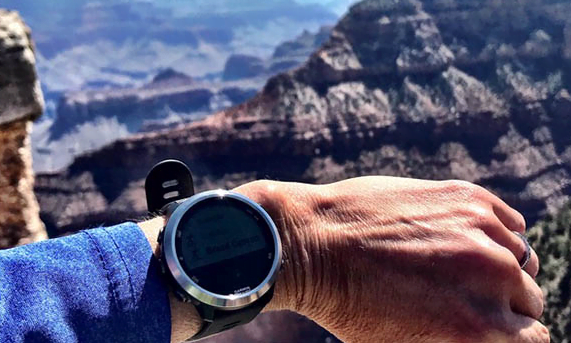
What to consider when buying a ‘smart’ watch that you also want to use for hiking
There’s an unlimited choice in respect to ‘Fitness’ watches, however, Apple is winning the market battle evidenced by its 50% market share (the last qtr. of 2020). Apple wins hands down on styling, ease of connectivity to devices, the simplicity of how the data is presented, and their super expensive environmentally unfriendly packaging. However, the battery on the Apple watch for example isn’t good enough for hiking and it doesn’t do the basics that are essential for hiking. Apple watches for starters need recharging every day and vitally can’t track your route or allow you to load maps.
What you should consider when buying a good hiking watch
-
GPS:
GPS tracking is one of the main differences between a hiking watch and the cheaper fitness watch solution.
A GPS watch allows you to instantly get the coordinates of your current location. By importing map routes you can then use them to navigate your way as the watch shows your current location as you walk along the track and in relation to the GPX route. Things like current speed, distance, ascent, and descent are also displayed.
They can also track and record your walk along a trail and allow you to export all the details like duration, distance, average speed, etc) to online platforms or specific mobile apps that relate to the brand of the watch or in some cases connect to other independent apps like STRAVA.
-
Battery Life
This is crucial when hiking, particularly if you are using the map functionality to navigate. No battery no map, no navigation, guess what you may be lost unless you have a spare physical paper map on hand or walk notes. Battery life is just as crucial when mapping walks, the battery runs out then potentially your walk day may be wasted if one of the goals was to map out the complete GPX file of the walk.
There are watches that have batteries that last a day or weeks. One thing for sure, if you are using the GPS function on your watch you will chew through its’ power very quickly. Maybe look into the watches that increase their charge with solar power. By the way for future reference consider bringing a power pack and the watch’s dedicated charging lead.
-
Durability:
This is important for hiking as the irregular graded tracks and rough terrain increase the likelihood of scratching or knocking the watch against rocks or trees among other things.
Hiking watches generally feature robust cases, highly durable straps, and advanced lenses for increased resistance against scratches. Some of the lenses are rated 1 point below diamond on the scale for hardness, but you can expect to pay for that privilege.
-
Water-Resistant
Rain is just one reason to consider waterproofing. But more importantly, when hiking there’s a real chance that you may slip or are even required to immerse your watch underwater. It’s also important if you choose to go for a swim, that way you don’t need to take it off or worse forget to.
Watches may only be water-resistant up to 30 meters, however, that’s more than enough unless you want to go deep-sea diving. In that case, you might need to buy a diving watch
-
Heart Rate Monitor:
Most hiking watches record heart rate with sophisticated optical technology, namely a wrist-based heart rate monitor. The chest-based strap transmitter that is sometimes purchased separately, are a little annoying to wear so I wouldn’t worry about buying that. Incidentally, if you want a more accurate reading just switch the watch so the face is on the inside of the wrist. It is great to check your heart rate when walking to see over time how it fluctuates. If you are particularly interested in getting your heart rate into fat burn territory when hiking, then this is gold.
-
Altimeter
Barometric altimeters measure air pressure, the higher the elevation, the lower the atmospheric pressure. This is useful as it also assists with the calculation of how far you have ascended, this is particularly important with high altitude hiking and the prevention of altitude sickness. It’s also good for understanding simply how far you might have hiked on a mountain climb and subsequent decision making with regard to fatigue levels, rest and what’s realistically achievable.
-
Compass:
All of the best GPS hiking watches include a compass. Don’t leave home without it.
- Weather:
Some watches have thermometers, this is especially useful for remote multi-day hikes where you are out of mobile range and access to weather reports is not possible. Note: the watch is impacted by your body temperature and a better measurement is obtained when not being worn.
-
Comfort
The comfort level of a watch is affected by its’ weight and the watchband. The lighter the watch the more comfortable, but I hesitate to say the watch has to be pretty heavy for this to really matter!
The watchband on the other hand can be extremely annoying. Watchbands that are soft and promote airflow will help to prevent sweat build-up.
-
Interface and functionality
Be aware that every watch has its own particular interface and it is going to be necessary to read the instructions. Continually pushing the buttons seems to work to an extent (I’m a man so that’s my go-to strategy), but if you want to understand the more complex functionality of these watches then there is no alternative then to get online and read the manual. Sorry!
-
The added functionality
Of course, there are a myriad of other functions that these watches have including answering your phone, counting your steps, monitoring your sleep (it is doubtful that this works in my opinion) and blood oxygenation. Watches even playing music are just some of the options. Very little of this functionality will benefit you when hiking and perhaps may even detract from the experience.
Our Recommendation
Based on our own research with our guides and staff we found that we all use Garmin. So that’s our recommendation based on reality. We believe Garmin wins hands down when it comes to using it as a hiking or walking adventure recorder.
Incidentally, I needed to purchase another Garmin watch on a walk on the Great South West Walk in early 2021. I inadvertently left my ‘old style’ recharging lead at home, so I bought a Garmin Instinct. At about $400 it does all I need it to do. I wear it all the time and the 6-year-old Fenix has now found its way into one of the guides kits. In any case, I’m sure they’d like to hear that it’s worth buying their more expensive product. Other than longer battery life, being able to play Spotify, measure blood oxygenation levels, a more durable lens, and so on and so on. If you are interested in getting more information on specific Garmin watches I think it is best to let Garmin explain the rest. By the way, we’re not getting anything from Garmin for writing this.

Enjoy your hike.
Brett
Co-Founder Stroll


There are no comments, be the first to comment.